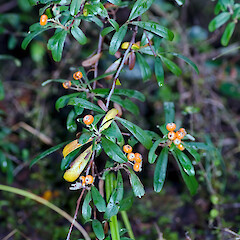Pyracantha angustifolia
Common name
orange firethorn
Family
Rosaceae
Flora category
Vascular – Exotic
Structural class
Trees & Shrubs - Dicotyledons
Conservation status
Not applicable
Habitat
Terrestrial.
Detailed description
Evergreen shrub up to 2.5m high. Leaf narrowly oblanceolate to oblong, up to 55 x 10 mm. Dark green and glabrous above, lanate and pale grey-green below, margin slightly recurved, entire or sometimes with a few minute serrations near tip of largest leaves. Corymbs up to approx. 30mm across; pedicels 6~18mm long, grey-tomentose. Sepals triangular, about .8mm long, greyish lanate, acute. Petals obovate or broadly elliptic, 3.5~5mm long, rounded, white. Stamens = petals. Fruit depressed-globose, 4~6 x 6~7mm, glossy orange.
Similar taxa
Can easily be separated from P. crenatoserrata and P. crenulata as it has smaller leaves that are hairy on the undersurface.
Flowering
December, January
Flower colours
White
Fruiting
April to August
Life cycle
Perennial. Viable seed is uncommon (Edgar and Connor 2000)
Year naturalised
1958
Origin
China
Reason for introduction
Ornamental
Etymology
angustifolia: From the Latin angustus ‘narrow, constricted’ and folius ‘leaf’, meaning narrow-leaved
National Pest Plant Accord species
This plant is listed in the 2020 National Pest Plant Accord. The National Pest Plant Accord (NPPA) is an agreement to prevent the sale and/or distribution of specified pest plants where either formal or casual horticultural trade is the most significant way of spreading the plant in New Zealand. For up to date information and an electronic copy of the 2020 Pest Plant Accord manual (including plant information and images) visit the MPI website.



